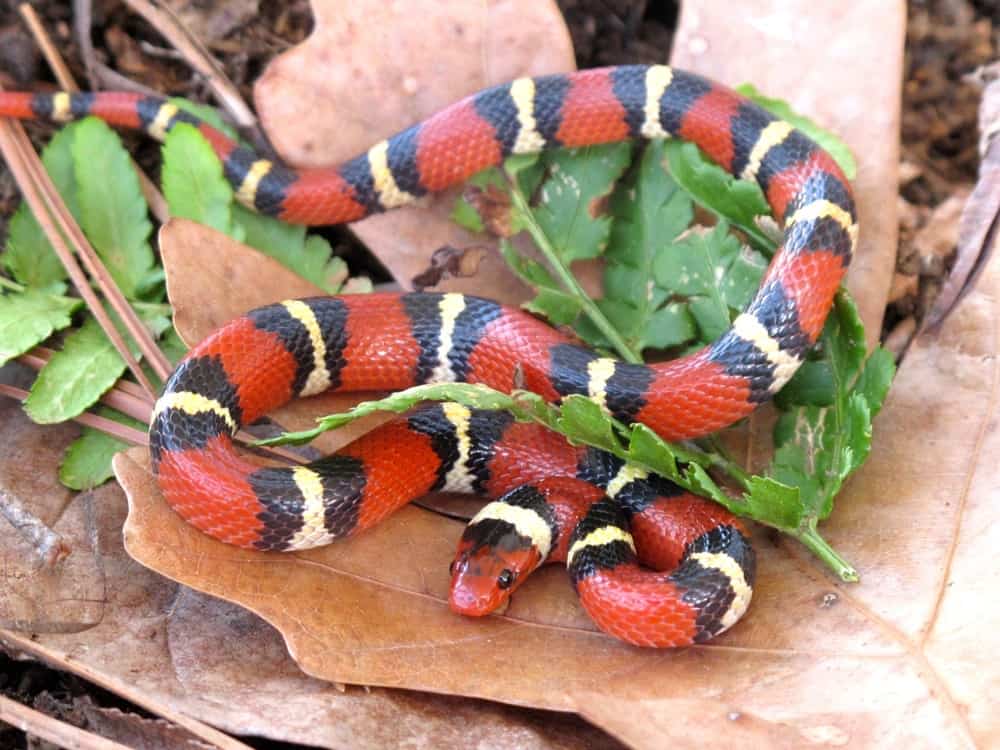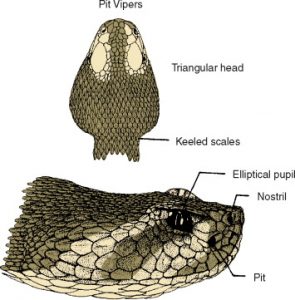The other day my daughter and I caught a cute little garter snake in our front yard. When I was trying to get her to hold it, she asked me if it was poisonous. I told her it wasn’t poisonous, and that if it did bite her it wouldn’t hurt. That’s what I was taught growing up, so it had to be true, right?
That night I found myself fact checking what I had told her. I wanted to make sure I was telling her the truth. I also wanted to be able to teach her how to identify venomous snakes so there was no doubt about it in the future.
*Pro Tip: If you’re wanting to pick up a snake but are questioning if it’s venomous, it’s best to just leave it alone.
 When it comes to identifying snakes, it is important to know the snakes native to the area you are in. There are over 600 species of venomous snakes in the world, but only 200 of them are deemed deadly to humans.
That being said, there are only four types of venomous snakes in the U.S. Each type contains many subspecies with size and color variations. This is to help them blend into their environment and become camouflage for their own protection.
Trying to identify a snake using color alone would be very difficult to do with any amount of accuracy. For example, venomous coral snakes and non-venomous scarlet king snakes both have a banded pattern of yellow, brown and black. The difference between the two types is that the red bands touch the yellow bands on a coral snake whereas red bands touch the black bands on scarlet king snakes.
Aside from this example, there is really no way to be absolutely positive if a snake is venomous by color alone.
When it comes to identifying snakes, it is important to know the snakes native to the area you are in. There are over 600 species of venomous snakes in the world, but only 200 of them are deemed deadly to humans.
That being said, there are only four types of venomous snakes in the U.S. Each type contains many subspecies with size and color variations. This is to help them blend into their environment and become camouflage for their own protection.
Trying to identify a snake using color alone would be very difficult to do with any amount of accuracy. For example, venomous coral snakes and non-venomous scarlet king snakes both have a banded pattern of yellow, brown and black. The difference between the two types is that the red bands touch the yellow bands on a coral snake whereas red bands touch the black bands on scarlet king snakes.
Aside from this example, there is really no way to be absolutely positive if a snake is venomous by color alone.
 Poisonous snakes in the United States are classified as pit vipers, which include most species of rattlesnakes. All snakes have heads that appear to be somewhat triangular, so it’s best to not try and tell if a snake is poisonous just by looking at its head.
Pit vipers are the most common snake in North America. A pit viper classification means the snake has heat-sensing pits under their eyes. The head will have a triangular shape and their eyes look like slits. Vipers will have fangs, which have venom sacks attached to them.
Poisonous snakes in the United States are classified as pit vipers, which include most species of rattlesnakes. All snakes have heads that appear to be somewhat triangular, so it’s best to not try and tell if a snake is poisonous just by looking at its head.
Pit vipers are the most common snake in North America. A pit viper classification means the snake has heat-sensing pits under their eyes. The head will have a triangular shape and their eyes look like slits. Vipers will have fangs, which have venom sacks attached to them.

 Conclusion
So, is the garter snake venomous? After doing all of this research we find that the garter snake is indeed NOT venomous. Garter snakes are one of the most common snakes in Northern America. Many people love having garter snakes in the neighborhood as they do a great job ridding homes of other pests like mice. Still, use caution when handling any snake, but now you know that these little guys won’t kill you.
Conclusion
So, is the garter snake venomous? After doing all of this research we find that the garter snake is indeed NOT venomous. Garter snakes are one of the most common snakes in Northern America. Many people love having garter snakes in the neighborhood as they do a great job ridding homes of other pests like mice. Still, use caution when handling any snake, but now you know that these little guys won’t kill you.
How to tell if a snake is venomous
According to SnakeRemoval.com, there are 3 common traits most venomous snakes have:- It is a big, fat snake (quite common to see these types of snakes in the United States versus other regions of the world)
- The snake has a rattle at the end of the tail
- It has elliptical pupils (Please don’t get close enough to figure this one out)
Can you tell if a snake is poisonous by its color?
 When it comes to identifying snakes, it is important to know the snakes native to the area you are in. There are over 600 species of venomous snakes in the world, but only 200 of them are deemed deadly to humans.
That being said, there are only four types of venomous snakes in the U.S. Each type contains many subspecies with size and color variations. This is to help them blend into their environment and become camouflage for their own protection.
Trying to identify a snake using color alone would be very difficult to do with any amount of accuracy. For example, venomous coral snakes and non-venomous scarlet king snakes both have a banded pattern of yellow, brown and black. The difference between the two types is that the red bands touch the yellow bands on a coral snake whereas red bands touch the black bands on scarlet king snakes.
Aside from this example, there is really no way to be absolutely positive if a snake is venomous by color alone.
When it comes to identifying snakes, it is important to know the snakes native to the area you are in. There are over 600 species of venomous snakes in the world, but only 200 of them are deemed deadly to humans.
That being said, there are only four types of venomous snakes in the U.S. Each type contains many subspecies with size and color variations. This is to help them blend into their environment and become camouflage for their own protection.
Trying to identify a snake using color alone would be very difficult to do with any amount of accuracy. For example, venomous coral snakes and non-venomous scarlet king snakes both have a banded pattern of yellow, brown and black. The difference between the two types is that the red bands touch the yellow bands on a coral snake whereas red bands touch the black bands on scarlet king snakes.
Aside from this example, there is really no way to be absolutely positive if a snake is venomous by color alone.
Common venomous snakes in the United States
 Poisonous snakes in the United States are classified as pit vipers, which include most species of rattlesnakes. All snakes have heads that appear to be somewhat triangular, so it’s best to not try and tell if a snake is poisonous just by looking at its head.
Pit vipers are the most common snake in North America. A pit viper classification means the snake has heat-sensing pits under their eyes. The head will have a triangular shape and their eyes look like slits. Vipers will have fangs, which have venom sacks attached to them.
Poisonous snakes in the United States are classified as pit vipers, which include most species of rattlesnakes. All snakes have heads that appear to be somewhat triangular, so it’s best to not try and tell if a snake is poisonous just by looking at its head.
Pit vipers are the most common snake in North America. A pit viper classification means the snake has heat-sensing pits under their eyes. The head will have a triangular shape and their eyes look like slits. Vipers will have fangs, which have venom sacks attached to them.
What to do if you see a snake
Encountering a snake in the wild is something you do need to be aware of as some are very dangerous. Always do research before a trip to know what snakes are native to the area, and which ones you need to watch for.- What to do if you encounter a snake
-
- If you see a snake, DO NOT pick it up. DO NOT poke at it with a stick. Freeze and slowly start backing away from the snake. Certain species of snakes will play dead but will strike when you are close. Don’t take the risk. Just leave it alone.
- A snake is less likely to strike if they do not view you as a threat. Make sure you are not cornering the snake. Always give the snake a way out.
- If a snake is coiled up, or you hear a rattle or puffing noise, proceed with caution. This usually means it’s ready to strike. Slowly back up until you are a safe distance away from the snake. This should settle it down and if you are lucky, it will slither away.
What to do if you’re bitten by a venomous snake
The good news for those in North America is that most of the snakes you see aren’t poisonous. The main snakes to watch out for are the coral snake, water moccasin, copperhead, and rattlesnake. If you encounter one, and you are on the unfortunate end of their bite, use these tips as soon as possible.
- Handling a snake bite
- Before you do anything else, call 911.
- Move a safe distance away from the snake and remain calm! Remind yourself that the chances of dying from a snake bite are close to none. Thanks to modern medicine in the United States, only one in 50 million people die from snake bites every year.
- DO NOT run or get your heart rate up. The faster your heart beats, the faster the venom will travel through your body.
- Remove tight clothing around the bite before your body starts to swell as it fights the venom.
- Position yourself to have the bite below the level of your heart so the venom doesn’t travel to your heart faster than it needs to.
- Clean the wound with fresh water, but do not flush it. Cover the wound and get medical attention immediately.
What is the difference between a poisonous snake and a venomous snake?
The common vernacular for a snake that has venom is a “poisonous snake”. After doing this research I’ve found that we’ve been saying it wrong this whole time.- A poisonous snake is a snake that will hurt you only if you eat it.
- A venomous snake is a snake that has venom and can hurt you through a bite.
Can you eat snakes?
The simple answer is yes. The vast majority of snake species are edible, regardless of whether they are venomous or not. A word of caution, snakes can eat rodents that could be poisoned with a toxic substance and that can pass to humans. Most snakes taste like chicken, right? I’ve had snake a few times in my life and from what I can tell, they all taste like chicken. I don’t think it’s a bad thing to eat snake. Especially if you’re in a survival situation. Before you jump in and just start killing yourself some snakes for dinner, please be aware of your local and state laws. If you’re interested in cooking up some snake for your next family party, I’d recommend checking out this article called “How to Cook A Snake in 8 Easy Steps“. What is the most venomous snake in the world?- The Fierce Snake or Inland Taipan is the most venomous of any snake in the world. A single bite could kill 100 people!
- Here’s a comprehensive, visual list of the most venomous snakes.
- To find which snakes are in your area of North America, use this interactive North American snakes.
- The cottonmouth, commonly known as the water moccasin, is the most dangerous snake in North America.
- Here is a venomous snake list for each state to help you know what snakes are native in your region.
 Conclusion
So, is the garter snake venomous? After doing all of this research we find that the garter snake is indeed NOT venomous. Garter snakes are one of the most common snakes in Northern America. Many people love having garter snakes in the neighborhood as they do a great job ridding homes of other pests like mice. Still, use caution when handling any snake, but now you know that these little guys won’t kill you.
Conclusion
So, is the garter snake venomous? After doing all of this research we find that the garter snake is indeed NOT venomous. Garter snakes are one of the most common snakes in Northern America. Many people love having garter snakes in the neighborhood as they do a great job ridding homes of other pests like mice. Still, use caution when handling any snake, but now you know that these little guys won’t kill you.
